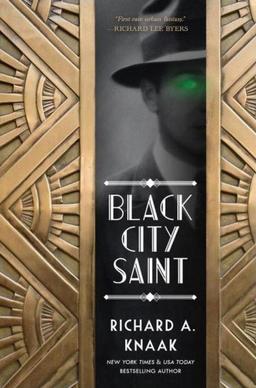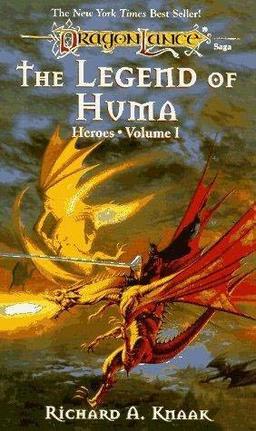Tommy Guns, Prohibition, and…. Magic?
 Epic fantasy has been and I think always will be a mainstay of the fantasy genre as a whole and it is for this which I am of course well-known thanks not only to my Dragonrealm saga, but also such shared worlds as Dragonlance, World of Warcraft, Pathfinder, Iron Kingdoms, and more. I certainly enjoy epic fantasy as well, naturally having read among so many others the Lord of the Rings. Still, as with most readers, I also enjoy a variety of other offerings in fantasy, especially urban fantasy… which leads me to Black City Saint.
Epic fantasy has been and I think always will be a mainstay of the fantasy genre as a whole and it is for this which I am of course well-known thanks not only to my Dragonrealm saga, but also such shared worlds as Dragonlance, World of Warcraft, Pathfinder, Iron Kingdoms, and more. I certainly enjoy epic fantasy as well, naturally having read among so many others the Lord of the Rings. Still, as with most readers, I also enjoy a variety of other offerings in fantasy, especially urban fantasy… which leads me to Black City Saint.
I have delved a bit into urban fantasy in the past, most notably Frostwing. Still, although I utilized Chicago as the background in that novel and two others, never before Black City Saint has the city, its history, and the characters been so entwined. It’s far simpler to merely set a story in a modern setting that everyone knows and put in those touches that remind the reader where they are. More complex — and at the same time more exciting for me as the author — is to turn to a time period that, although not all that long ago, remains sharply different from that in which we live. Having grown up around the Chicago area, I had heard many of the names, many of the stories, concerning the prohibition era. Always a fan of the mystery genre, I assumed that I might use those stories in that way, but the notion of Nick Medea entered and changed everything.
I love the mixing of genres. Some of my favorite novels include mysteries with magic. It was therefore not at all surprising to me that I took a few steps farther than I had with my previous excursions into urban fantasy and introduced into Roaring Twenties Chicago possibly the least likely protagonist — St. George of dragon fame.
And, yes, the dragon came with him.
Adding a character such as St. George into the mix meant making certain that the world he lived in had even more depth. With his lengthy life, that meant research had to go back beyond the Roaring 20s, which in turn brought into the story new elements that not only helped cement character development, but added to the depth of the city itself. The actual history of Chicago became a character of its own, molding the story and the protagonists in the process.
 Most of my work in epic fantasy has taken place in mythical realms. Either I or someone else had put together a nice, handy file on details from which to draw. Researching history, on the other hand, can be a much more complex project, especially when verifying when and how certain events took place. Then comes melding those events into the lives and circumstances of the characters — especially Nick Medea a.k.a. St. George (and, yes, St. George’s current name has a history) — and making them fit properly. Indeed, in the case of Nick, some of those past events actually turned out to become very relevant to the Roaring Twenties and the plot going on.
Most of my work in epic fantasy has taken place in mythical realms. Either I or someone else had put together a nice, handy file on details from which to draw. Researching history, on the other hand, can be a much more complex project, especially when verifying when and how certain events took place. Then comes melding those events into the lives and circumstances of the characters — especially Nick Medea a.k.a. St. George (and, yes, St. George’s current name has a history) — and making them fit properly. Indeed, in the case of Nick, some of those past events actually turned out to become very relevant to the Roaring Twenties and the plot going on.
More so than anything, I enjoy the proverbial fish out of water. I especially enjoyed putting a character such as the former saint in Prohibition Chicago and seeing how he and those around him adjust. Contrast makes for good story. I was able to add other characters tied to Nick who were, in their own way, just as out of sync with their surroundings and situations as him. There’s Fetch, the shapeshifter who, because he is trapped in Chicago, must remain in a canine form. This is a creature who was once the assassin of the Feirie Court. There is Claryce Simone, reincarnated again and again, only to die, again and again. There is the ghost of the emperor Diocletian, ever seeking from Nick what Nick cannot give him…forgiveness for having Saint George executed for merely being who he was.
Most of all, there is the dragon, ever with Nick and ever resentful of that fate. The dragon, ever seeking escape. The dragon, the true cause of the Great Chicago Fire, yet another historical event with elements adding to the depth of the city as a character. Bringing the dragon to Chicago without making his presence overwhelm the city was a tricky thing, but I like to think things worked out well. The dragon becomes as integral to the story as Nick himself, both a protagonist and an ever-present part of the background. The dragon, in fact, could be said to be more at home in such a surrounding than Nick, who still retains the experiences of his past life while seeking to guard the gateway between the mortal plane and the court of Feirie.
And even the rival gangs of Chicago, specifically those of Capone’s Outfit and Moran’s North Siders, have their parts to play, including their interactions, knowingly and otherwise, with the Wyld, the renegades of Feirie. What on the surface follows history as we know it may have a magical level underneath, a darker, truer meaning.
Authors mixing genres or mixing history with fantasy has given me some fascinating reads over the years. Now, with Black City Saint, I hope that I have added an entertaining one for other readers.
Richard A. Knaak is the New York Times– and USA Today-bestselling author of The Legend of Huma, WoW: Wolfheart, and nearly fifty other novels and numerous short stories, including works in such series as Warcraft, Diablo, Dragonlance, Age of Conan, and his own Dragonrealm. He has scripted a number of Warcraft manga with Tokyopop, such as the top-selling Sunwell trilogy, and has also written background material for games. His works have been published worldwide in many languages. His most recent releases include Shade—- a brand-new Dragonrealm novel featuring the tragic sorcerer — Dawn of the Aspects — the latest in the bestselling World of Warcraft series, and the fourth collection in his Legends of the Dragonrealm series. He is presently at work on several other projects.
Knaak was a miss for me but I might try him out with this setting and story.
My first thought on reading the background for the book was, “And the Dragon caused the Great Chicago Fire …” Nice to see I was on the right track. Now, I have to figure out which member of Feirie instigated the Black Sox scandal for the 1919 World Series, before I read the book.
As for the “alias” of Nick Medea, hmm, I would have probably wimped out and gone with “George Farmer”, being a bit more obvious-minded.
The Black Sox scandal—-that stuff has to be the fodder for the heart of evil.
WA,
Oh, it is a good candidate for Ultimate Evil, especially to baseball fans. But, it does make for some great fiction (The Great Gatsby draws on it) with its “shades of grey” morality play. As Bill James, the baseball analyst put it, if Charles Comiskey, the owner, is in the Hall of Fame, why not Shoeless Joe Jackson? If Shoeless Joe is banned, why not Comiskey?
Me, I blame the Winter Court for leading the Boys of Summer astray.